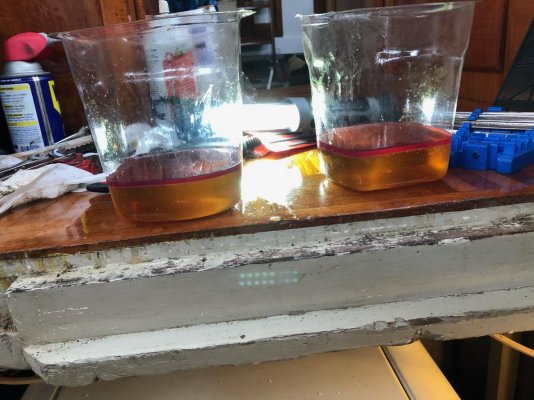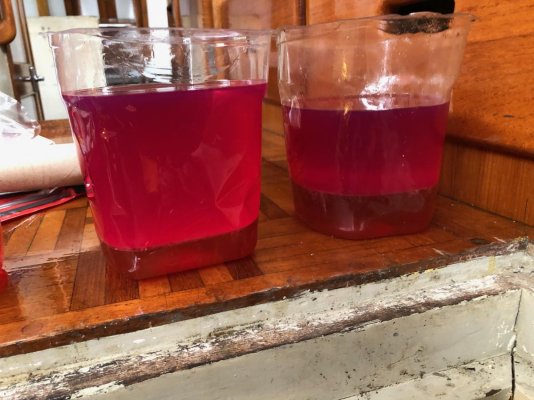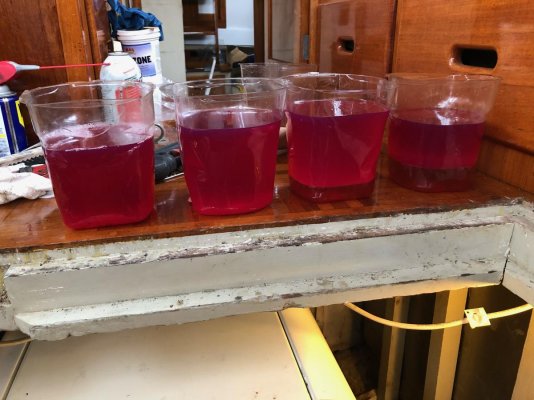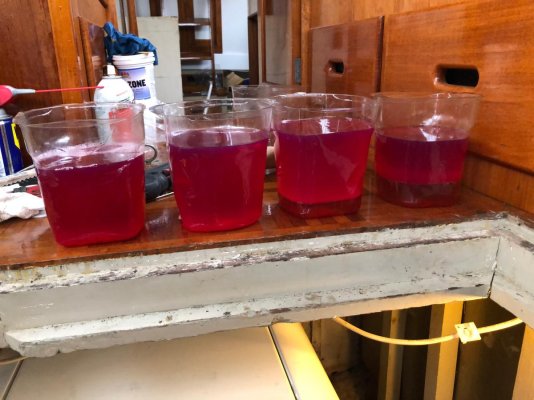C lectric
Guru
Disconnect the pipes to the injectors and best remove them and drain of any contaminated fuel and flush in a clean pan with clean fuel. B low them out with compressed air.. or at least swing them out of the way enough that the injectors are in the open. Take a couple photos to help replace them as they often are fed between each other.. Number each of the pipes in order marking one end that either goes to which injector or comes from which injector pump outlet. These pipes will have a particular order of removal/ installation.
Cover the injection pump outlets with lots of rags.
Disconnect the hose between the lift pump on the side of the engine and the two filters and drain/clean it .
Change the two on engine filters and clean out any of the mess as best you can.
Disconnect the hose between the on engine filters and the injection pump and drain/clean it.
Use a hand pump to push new fuel through the lift pump into a bucket or use the little priming pump lever. You want all the contaminated fuel out that you can remove. Actually an outboard fuel line with the squeeze bulb should be good for this. Just watch the bulb for the arrow to ensure it pushes the right way.
Once the lift pump is cleared and the filters changed then reconnect the hose between it and the two filters and do the same untill you get clean fuel into and out of the filters.
Reconnect the hose between the filters and the injection pump and continue pumping so fresh fuel is forced into the injection pump through the filters and lift pump.
It may be tough to squeeze the fuel through the inj. pump. Do as much as you can.
I think I would also remove and drain the pipes clear with compressed air. Then I would crank the engine so each of the outlets spit out any fuel in them being replaced by new fuel. That's why the heavy rags. I would think 10 sec or so would be enough. replace the pipes in order with new washers at each end and reconnect to the injectors.
Then you will need to do the typical bleed procedure leaving the injector nuts somewhat loose and cranking the engine again untill fuel spits out any remaining air and then try starting the engine which will clear the injectors of any bit of contaminated fuel.
Best would be a removal to a shop for cleaning and inspection but I think I would try first and see how it runs.
Of course as each cylinder fires tighten the pipe nuts up being carefull as the now high pressure fuel can do you harm. Hopefully the engine runs well.
If not then you may have to take the injectors in.
And after all is done change the injector pump sump oil if yours have that sump.
Hope this helps.
Don't forget that the Racor needs to be changed and cleaned well,, the lines from the tank to the Racor and between the Racor and the lift pump should be drained and blown out.
Cover the injection pump outlets with lots of rags.
Disconnect the hose between the lift pump on the side of the engine and the two filters and drain/clean it .
Change the two on engine filters and clean out any of the mess as best you can.
Disconnect the hose between the on engine filters and the injection pump and drain/clean it.
Use a hand pump to push new fuel through the lift pump into a bucket or use the little priming pump lever. You want all the contaminated fuel out that you can remove. Actually an outboard fuel line with the squeeze bulb should be good for this. Just watch the bulb for the arrow to ensure it pushes the right way.
Once the lift pump is cleared and the filters changed then reconnect the hose between it and the two filters and do the same untill you get clean fuel into and out of the filters.
Reconnect the hose between the filters and the injection pump and continue pumping so fresh fuel is forced into the injection pump through the filters and lift pump.
It may be tough to squeeze the fuel through the inj. pump. Do as much as you can.
I think I would also remove and drain the pipes clear with compressed air. Then I would crank the engine so each of the outlets spit out any fuel in them being replaced by new fuel. That's why the heavy rags. I would think 10 sec or so would be enough. replace the pipes in order with new washers at each end and reconnect to the injectors.
Then you will need to do the typical bleed procedure leaving the injector nuts somewhat loose and cranking the engine again untill fuel spits out any remaining air and then try starting the engine which will clear the injectors of any bit of contaminated fuel.
Best would be a removal to a shop for cleaning and inspection but I think I would try first and see how it runs.
Of course as each cylinder fires tighten the pipe nuts up being carefull as the now high pressure fuel can do you harm. Hopefully the engine runs well.
If not then you may have to take the injectors in.
And after all is done change the injector pump sump oil if yours have that sump.
Hope this helps.
Don't forget that the Racor needs to be changed and cleaned well,, the lines from the tank to the Racor and between the Racor and the lift pump should be drained and blown out.
Last edited:




